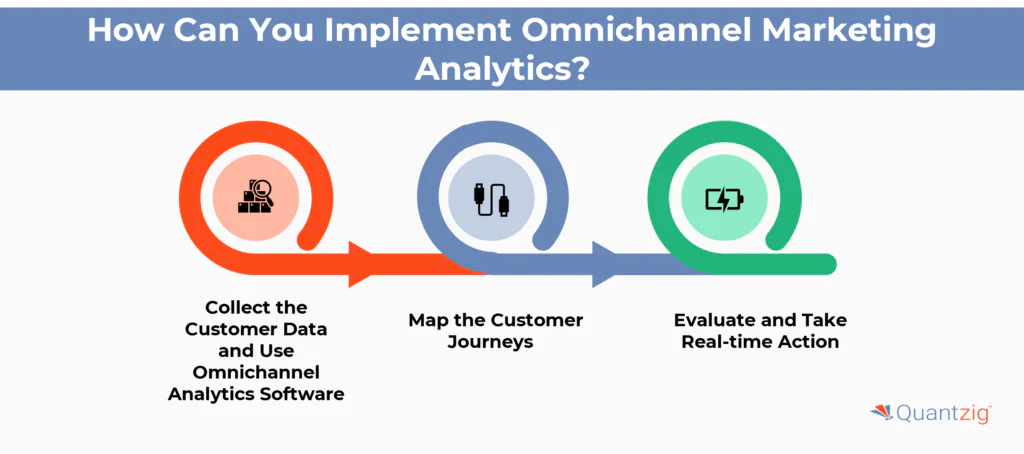Written By: Associate Vice President, Analytics and Data Strategy, Quantzig
Table of Contents
Key Takeaways for Omni-Channel Marketing Analytics
- Quantzig’s Omnichannel Marketing Analytics Solution helped a UK-based retailer to achieve an increased lead conversion by 15% for the same budget and increased customer response to the campaign by 30%.
- Taking an omni-channel approach to analyzing marketing data is vital for companies that want to provide smooth, tailored experiences for their clients, enhance their marketing campaigns, and achieve lasting prosperity as the world becomes more digital.
- Implementing an Omnichannel Marketing Analytics solution presents numerous challenges including formatting complexities due to varied and changing data formats, inconsistent data quality stemming from extracting data from multiple sources, difficulties in data integration and harmonization, and compliance with evolving data privacy and security regulations, impeding effective omnichannel marketing strategies.
- Implementing Omnichannel Marketing solutions enables businesses to achieve increased Marketing ROI, higher lead conversion rates, broader marketing coverage, and heightened customer engagement by leveraging seamless, personalized experiences tailored across various channels, thereby optimizing marketing efforts and fostering long-term success in a digital and competitive environment.
Introduction
Omnichannel analytics uses customer information collected from all your marketing channels to build a full view of your marketing results, enhance user satisfaction, and streamline business operations. The concept behind omnichannel analytics is to combine data from fragmented origins to gain a meaningful understanding of consumer actions and identify the touchpoints that generate the most revenue. This case study will shed light on how Quantzig’s Omnichannel Marketing Analytics Solution helped a UK-based retailer to achieve an increased lead conversion by 15% for the same budget and increased customer response to the campaign by 30% on average as compared to average conversion and response in the last 12 months of the campaign of similar size.
Book a demo to experience the meaningful insights we derive from data through our analytical tools and platform capabilities. Schedule a demo today!
Request a Free DemoQuantzig’s Omni-Channel Marketing Analytics Solution for a Retail Brand
| Client Details | A leading retailer based in the UK with a diverse product portfolio. |
| Challenges Faced by The Client | The client faced the challenge of operating omnichannel campaigns without access to comprehensive marketing analytics, resulting in an inability to optimize campaign effectiveness and budget allocation decisions for improved ROI. |
| Solutions Offered by Quantzig | We developed an Omnichannel Marketing Solution that involved a combination of data analytics and a business intelligence dashboard to provide insights into performance. |
| Impact Delivered | The lead conversion increased by 15% for the same budget and the customer response to the campaign increased by 30% on average as compared to average conversion and response in the last 12 months of the campaign of similar size |
Client Details
A leading retailer based in the UK with a diverse product portfolio.
Challenges in Omni-Channel Marketing Analytics Faced by the Client
The client did not have an Omnichannel Marketing Analytics solution and was managing the omnichannel campaigns using previous campaign returns on investment and the Budget set aside for upcoming campaigns. There was an absence of insights to examine further changes that could be made to improve campaign effectiveness. Additionally, there was insufficient data to support modifications to budget allocations for increased return on investment.
Omni-Channel Marketing Analytics Offered by Quantzig for the Client:
We developed an Omnichannel Marketing Solution for a retailer based in the UK. The solution involved a combination of data analytics and a business intelligence dashboard to provide insights into performance. It assisted in providing an understanding of the budget allocations across each channel, reallocating budgets between channels based on customer feedback, eliminating underperforming channels, determining ideal campaign lengths for different campaigns, and sequencing the various channels for maximum impact.
Impact Delivered using Quantzig’s Expertise:
The lead conversion increased by 15% for the same budget and the customer response to the campaign increased by 30% on average as compared to average conversion and response in the last 12 months of the campaign of similar size. The solution also helped in providing insights around underperforming channels and consistently performing channels
Also Read: Maximizing Marketing Budgets with Campaign ROI Analysis
Get started with your complimentary trial today and delve into our platform without any obligations. Explore our wide range of customized, consumption driven analytical solutions services built across the analytical maturity levels.
Start your Free Trial TodayWhat Exactly is Omni-Channel Marketing Analytics?
Omnichannel marketing analytics is the collection and analysis of a wide range of customer data across interactions on all types of communication channels. The insights gained from this analysis help organizations deliver a personalized, cohesive experience as they move from touchpoint to touchpoint and channel to channel. Taking the omnichannel approach to analytics is critical to successfully profiling modern target audiences. Nowadays, customers don’t use one device or channel to connect with the companies-they often jump from various social media platforms to in-person visits and web chats. Google research has revealed that 90% of people who use multiple devices switch between them to finish tasks, using an average of three different device combinations daily. According to Quantzig experts, although younger people are most inclined to use self-service options on their phones, 53% of consumers would rather speak on the phone or meet in person when dealing with common interactions.
Why is Omnichannel Analytics Important?
Here are some important reasons why omnichannel marketing analytics is the best way to transform and capture customer experiences.
1. Understand Customer Pain Points and Resolve Issues
Fragmented interactions with customers or interrupted experiences across various channels can be eliminated with analysis that looks at all channels together. With the entire customer experience laid out on one platform, you can easily identify, and repair broken experiences, which often originate before the channel where the issue appears. Getting to the root of the problem, this kind of data analysis lets you break down data silos, spot inefficiencies and reliably deliver excellent experiences at scale.
2. Offer a More Personalized and Seamless Experience that Improves Revenue and Drives Growth
Companies that utilize at least three retail channels have 287% higher purchase rates compared to brands using just one channel. This shows that providing a smooth omnichannel experience can generate more revenue. However, customer journeys filled with friction and annoyance can negatively impact experiences, leading to higher customer turnover rates.
Simplifying this work on a large scale gets easier with revolutionary insights into effort, attitude, and emotional strength, which can be uncovered through analytics across all channels. You can stop customers from switching channels to avoid confusion or effort, or even worse, abandoning you for a competitor. Preventing abandonment in real-time or through your customer service team can be enabled by Data visualization tools and online channels and offline channels like Natural Language Understanding (NLU) that identify emotion, effort, and more and propose remedial actions.
Even better, you can provide personalized customer experiences tailored to each customer’s specific needs, but on a huge scale. With superior, more personalized experiences, customer satisfaction and loyalty can be boosted across the board.
3. You Can Save Your Team Effort and Time
Leveraging an all-encompassing omnichannel analytics platform can remove the grunt work for your teams, who frequently operate in isolated units where problems can slip through unnoticed. Providing everyone on your staff with a single source of truth, with all information contained in one system, can boost business productivity. With role-specific dashboards tailored to each group, including your customer service reps, physical location employees, and digital channel personnel, you’re able to conserve time and energy for your staff while enhancing communication. Your teams’ work can be redirected toward more intricate and critical matters.
Omnichannel Analytics and AI
Omnichannel marketing analytics enables the use of artificial intelligence to gain deeper insight into customer journeys. This AI-driven analysis is bringing about a new age of customer experience, producing memorable and repeatable purchasing experiences that customers come back to repeatedly. Since you can now comprehend a customer’s intent, sentiment, effort, and emotional intensity by deducing it from their language or behavioral cues, you can easily provide digital experiences that go above and beyond.
With businesses focused on multi-channel seeing a 7.5% annual reduction in cost per contact, it’s not only simpler to convert consumers, but more cost-effective with a multi-channel approach empowered by AI.
Also Read: Track Business Progress with Marketing Analytics Dashboard
Experience the advantages firsthand by testing a customized complimentary pilot designed to address your specific requirements. Pilot studies are non-committal in nature.
Request a Free PilotHow Can You Implement Omnichannel Marketing Analytics?
Implementing Omnichannel Marketing Analytics Solutions is an effective digital transformation, but accurate technologies are required to implement omnichannel marketing analytics solutions.
Here’s your comprehensive guide on how to actualize your omnichannel marketing analytics solution:
1. Collect the Customer Data and Use Omnichannel Analytics Software
Your analytics solution should have the capability to gather data from various channels and turn it into actionable insights. It should be able to provide observations to your teams in near real-time, taking customer information and transforming it into useful journey insights.
Your cross-channel analytics software should be able to:
- Collect customer data from multiple touchpoints like calls, chats, social media, review sites, etc., and combine it into comprehensive customer profiles
- Automatically understand customer intent, emotion, effort, sentiment, etc. using technologies like Natural Language Understanding (NLU) and add this to existing data on customer satisfaction metrics and more
- Pinpoint opportunities to enhance operational efficiency
- Have predictive analytics built-in to assist you in planning future marketing efforts and more
- Have predictive analytics built-in to assist you in planning future marketing efforts and more
The optimal omnichannel analytics solution should be able to combine smoothly with the various tools and online channels already being used by your company so that it causes very little interruption to your employees’ workflows.
2. Map the Customer Journeys
Outstanding cross-channel analytics tools will enable you to gain profound insight into customer journeys. Depicting these journeys will assist you in grasping which channels yield the highest conversions and the reasons behind that, as well as how to motivate prospective customers to pursue optimal paths.
You ought to have the capacity to address questions like:
Which channels are favored by our clients?
Are there common cross-channel journeys that result in conversions?
Where do customer journeys falter?
What measures could rectify these broken journeys?
3. Evaluate and Take Real-time Action
It is crucial to assess your findings and enhance results for omnichannel analytics to generate a return on investment. Your data should not just exist within your software system – the metrics you monitor ought to guide you to where modifications can be made to improve customer experiences. Evaluating customer conversations, customer segments, and feedback close to real-time can assist you in keeping up with what’s occurring right now. Automated workflow technology – like xFlow – enables you to notify teams, open tickets, and close information gaps by automatically triggering actions based on customer behavior and more.
Challenges while Implementing Omnichannel Marketing Analytics Solutions
There are various difficulties in rolling out an Omnichannel Marketing Analytics platform. Pulling data from multiple places can result in inconsistent information, causing problems with data quality. There are formatting complications since data sources are diverse and the configuration persists changing whether we utilize crawlers or APIs. Data Integration and Harmonization is also tricky because of the assorted sources and unreliable data from the origin. Expanding Data Privacy and Security rules also make it tough to possess the relevant data required to steer omnichannel marketing.
How to Choose Omnichannel Analytics Software?
The analytics platform you use across all your sales and communication channels should give you a deep understanding of your customers’ interactions and full profiles. It ought to help you deliver excellent customer service, foresee what customers will likely do, and boost customer loyalty.
1. Track Capabilities Across the Customer Channels
Customer experiences happen across many different channels. Your analytics system that looks at all channels (omnichannel) should be able to bring together all your customer information in one place. This can include watching mobile apps, websites, self-service choices, phone calls, chat conversations, social media, ratings and reviews on other websites, surveys, and messaging – all digital interactions.
2. A Formidable Text and Speech Analytics Engine
The analytics software for your omnichannel strategy should have Natural Language Understanding (NLU) capabilities to provide insights to your teams almost instantly. For example, the Agent Assist feature can assess messaging conversations and give your contact center employees a sharp comprehension of each customer’s situation. Additionally, it can recommend ways to assist them.
3. Proper Customer Profiling
Customer profiles that contain a wealth of behavioral, preferential, and activity data can be far more useful than just having demographic information. Incorporating operational data into a customer profile along with other customer data to create a comprehensive profile will make insights gained from analyzing customer interactions, customer segments, and customer behavior patterns across all channels more impactful.
Conclusion
In today’s dynamic business landscape, Omnichannel marketing has emerged as a critical strategy for retailers seeking to connect with consumers across multiple touchpoints. To effectively navigate this terrain, businesses must harness the power of Omnichannel analytics to glean insights from diverse marketing data sources, spanning both online channels and offline channels. Leveraging advanced technologies and expertise in data visualization, organizations can unlock valuable customer data insights, enabling them to optimize marketing performance and tailor marketing actions to specific customer segments and customer behavior patterns.
By embracing a Marketing Common Data Model, retailers can streamline data tracking processes and overcome the limitations of traditional analytics tools. Through a comprehensive understanding of Omnichannel Marketing Analytics, businesses can drive increased Marketing ROI, higher lead conversion, broader marketing coverage, and heightened customer engagement, ultimately fostering sustainable success in an ever-evolving marketplace.






